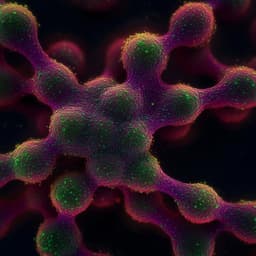
Engineering and Technology
Birdlike broadband neuromorphic visual sensor arrays for fusion imaging
P. Xie, Y. Xu, et al.
Discover groundbreaking research by Pengshan Xie and colleagues on a novel van der Waals P3HT/GaAs nanowires P-N junction. This innovative broadband neuromorphic visual sensor array combines non-volatile storage capabilities with low-light perception and minimal power usage, achieving remarkable color recognition and fusion imaging accuracy.
~3 min • Beginner • English
Introduction
The study addresses the challenge of achieving low-power, broadband, in-memory sensing and computing for machine vision at the sensory terminal. Traditional vision pipelines separate sensing, memory, and processing, causing high data transfer energy, latency, and cost, particularly as sensors scale in frame rate and pixel density. The authors aim to emulate bird-like visual enhancement—broad spectral perception (including UV), low-light sensitivity, and efficient preprocessing—within a unified device that integrates sensing, storage, and computation. They propose a dual-junction design (van der Waals P3HT/GaAs P–N junction plus Schottky junction) to enable broadband non-volatile optoelectronic synaptic behavior and near-zero-power operation, and demonstrate array-level functionality and fusion imaging with reservoir computing.
Literature Review
Prior organic and hybrid optoelectronic synapses have shown progress but face limitations in volatility or spectral bandwidth. Chen et al. developed an organic electrochemical optoelectronic synapse with donor–acceptor bulk heterojunction interfaces, providing large photocurrent at low voltage and non-volatile conductance modulation across visible wavelengths for memorization and neuromorphic computing. Huang’s group co-designed material and algorithm using a light-responsive semiconducting polymer with efficient exciton dissociation and through-space charge transport; their three-terminal neuromorphic device achieved in-situ sensing, memorization, and preprocessing (contrast enhancement, noise reduction) and dynamic reservoir computing. Liu et al. demonstrated an ion-based organic memristive matrix leveraging semi-crystalline macromolecules to support cation migration for artificial synapses. However, many such systems either lack robust non-volatile retention or do not cover sufficiently broad spectral ranges (from solar-blind UV to NIR) for broadband in-memory sensing and computing; large-scale integration without complex transfers of diverse 2D materials remains challenging. This work addresses these gaps via a vdWs organic/inorganic P–N junction combined with Schottky contacts for broadband, non-volatile, integrable operation.
Methodology
Device concept and fabrication: A dual-junction birdlike broadband neuromorphic visual sensor (BBNVS) was constructed by combining an out-of-plane van der Waals P–N junction and in-plane Schottky junction. Self-assembled P3HT films were formed at the air/water interface by drop-casting P3HT/toluene solution (10 mg mL−1) onto deionized water; as toluene evaporated (≈2 min), intermolecular π–π stacking and hydrophobic interactions yielded an ordered, edge-on stacked film. Film thickness was controlled by solution volume/concentration; AFM and SEM confirmed smooth, pinhole-free films (e.g., 65 nm, RMS roughness ≈5.37 nm). Raman mapping verified large-area uniformity.
GaAs nanowire (NW) arrays were synthesized by a two-step catalytic solid-source CVD/chemical vapor transport method on Si/SiO2 using Au catalyst: downstream zone 800 °C anneal of Au, first nucleation at source 800 °C and downstream 640 °C for 1–2 min, then second-step growth at 570 °C for 30 min under H2 (100 sccm). NWs were characterized by SEM, HRTEM, and EDS mapping (uniform Ga and As distributions). NW arrays were assembled onto Si/SiO2 substrates via dry contact printing; photolithography defined 2 µm channels for NW testing (Ni S/D), showing n-type transfer characteristics.
Heterojunction assembly: Large-area self-assembled P3HT films were physically transferred onto printed GaAs NW arrays (vdWs contact confirmed by Raman with negligible peak shifts). Ag source/drain electrodes (50 nm) were thermally evaporated through a shadow mask (rate 0.5 Å s−1) to form Schottky contacts; device channel width and length were 1000 µm and 80 µm, respectively. The resulting structure established an out-of-plane P3HT/GaAs P–N junction and in-plane P3HT/Ag Schottky junction. A back-gate geometry on n++ Si/SiO2 enabled three-terminal operation and gate modulation.
Characterization and analysis: Electrical and optoelectronic measurements were performed using a probe station with an Agilent 4155C analyzer. Optical stimuli across UV–visible–NIR (including solar-blind 261 nm and NIR up to 1550 nm) were delivered via lasers with power calibrated by a Thorlabs PM400; modulation via a function generator. Synaptic behaviors (EPSC, spike-number/intensity dependent plasticity) were evaluated, including self-powered mode at VGS=0 V and VDS=0 V. Structural and interfacial characterization included AFM, SEM, HRTEM, Raman/PL spectroscopy, GIWAXS (Shanghai Synchrotron), and XPS. DFT (VASP) simulations probed P3HT/Ag charge transfer and band bending.
Array and flexible integration: 5×5 device arrays were fabricated for optical image storage and stability tests. P3HT films were transferred to various substrates (glass, acrylic, PET, PDMS, PI) to assess flexibility and bending robustness; Raman under stress compared vdWs-transferred vs spin-coated films on NWs. Device orientation effects (NWs perpendicular vs parallel to channel) on storage performance were studied.
Reservoir computing (RC): A dynamic RC framework converted preprocessed image frames into temporal pulse strings per pixel/channel (RGB and UV). Sub-reservoir pixel matrices processed motion (blue-coded) and color (orange-coded) tasks; three devices per color sub-reservoir handled R/G/B inputs. Readout employed fully connected layers for classification. A demonstration used a moving red ball patterned with transparent sunscreen to test motion, color, and UV grayscale perception and fusion imaging across visible and UV views.
Key Findings
- Broadband, non-volatile optoelectronic synapse: BBNVS responds from solar-blind UV (261 nm) to NIR (up to 1550 nm), with linear synaptic weight updates across wavelengths and powers. Under continuous 261 nm pulses (0.32 mW cm−2, 1 Hz), >128 stable memory states were achieved.
- Visible-range multi-bit storage: Over 5 bits of in-memory sensing and computing in blue (450 nm) and green (532 nm); 4 bits in red (635 nm). Spatiotemporal 4-bit coding was also demonstrated.
- Positive and negative photoconductivity: Persistent PPC at VGS=0 V; NPC with inhibitory postsynaptic potential achieved under negative gate bias (VGS=-5 V), including >5-bit NPC states under 450 nm pulses (interval 10.5 s). NPC attributed to interfacial recombination/scattering and capacitive coupling under negative gate bias.
- Low-light enhancement: P–N junction-enabled carrier separation and injection enhanced photocurrent by >6× versus P3HT-only devices, improving dim-light perception.
- Self-powered operation: With built-in fields from P–N and Schottky junctions, devices operated at VGS=0 V and VDS=0 V, mimicking synaptic behaviors with near-zero power consumption.
- Threshold shift and retention: After solar-blind and visible irradiation, transfer curves showed consistent Vth shifts >20 V (increased hole concentration) and persistent stored photocurrent. A 5×5 array stored an H-shaped optical pattern stably preserved after 1000 s.
- Structural basis: GIWAXS revealed highly ordered edge-on P3HT with strong out-of-plane (100) diffraction; PL mapping and XPS indicated carrier separation/transfer at P3HT/GaAs interface; DFT showed electron transfer from P3HT to Ag and upward band bending supporting retention.
- Flexible/wearable integration: Devices fabricated on glass, acrylic, PET, PDMS, and PI maintained performance under bending/twisting; vdWs transfer alleviated stress-induced spectral changes compared to spin-coated films, enabling robust operation even under folding. NW orientation perpendicular to channel improved storage via stronger photo-gating.
- RC performance and fusion imaging: RC using BBNVS achieved up to 94% accuracy on a self-built color dataset. Demonstrations included simultaneous motion trajectory extraction, color recognition, and UV grayscale pattern revelation (sunscreen) of a moving red ball, enabling UV–visible fusion imaging. The leaner array/readout design used about half the parameters of prior approaches while avoiding complex arithmetic, yet handled complex recognition scenarios.
Discussion
The dual-junction BBNVS directly addresses the need for integrated sensing-memory-compute in machine vision by emulating avian visual features: extended spectral sensitivity (including UV), enhanced low-light detection, and persistent memory. The vdWs P3HT/GaAs P–N junction supplies efficient carrier generation, separation, and trapping, while the P3HT/Ag Schottky barrier provides in-plane retention and built-in fields that enable self-powered operation. The ordered edge-on P3HT microstructure furnishes efficient π–π transport channels and out-of-plane recombination barriers, underpinning non-volatile storage and multi-bit synaptic states under both PPC and NPC regimes. At the system level, the 5×5 arrays demonstrate homogeneous, stable in-memory optical storage, and the RC framework leverages the device’s intrinsic dynamics for low-overhead training and temporal feature mapping. The combined broadband response and non-volatility simplify preprocessing and data transfer bottlenecks, enabling real-time, low-power perception of color, motion, and UV grayscale. Robust performance on flexible substrates positions the platform for wearable and bio-integrated applications, while the demonstrated UV–visible fusion imaging exemplifies how multimodal sensing can be consolidated into a single neuromorphic hardware layer.
Conclusion
This work presents a dual-junction birdlike broadband neuromorphic visual sensor array combining a vdWs P3HT/GaAs P–N junction with a P3HT/Ag Schottky junction to realize: (1) non-volatile broadband optical storage from solar-blind UV to NIR, (2) enhanced low-light perception, and (3) near-zero-power self-powered operation. The devices achieve persistent PPC and NPC with over 5-bit memory states in blue/green and 4-bit in red, surpass 128 states under solar-blind UV, and show Vth shifts >20 V with stable array-level retention. A 5×5 array demonstrates integrability, and physical transfer of self-assembled P3HT enables operation on diverse flexible substrates. Coupled with a reservoir computing system, the platform attains up to 94% color recognition accuracy and performs motion, color, and UV grayscale extraction for UV–visible fusion imaging. The intrinsic dynamic non-volatility and lean array design offer promising routes toward efficient, wearable, and biomimetic neuromorphic vision with spatiotemporal information recognition. Future efforts envisioned by the authors include broader application of the leaner array design and advancing bionic spatiotemporal recognition using the device’s internal dynamics.
Limitations
Related Publications
Explore these studies to deepen your understanding of the subject.







